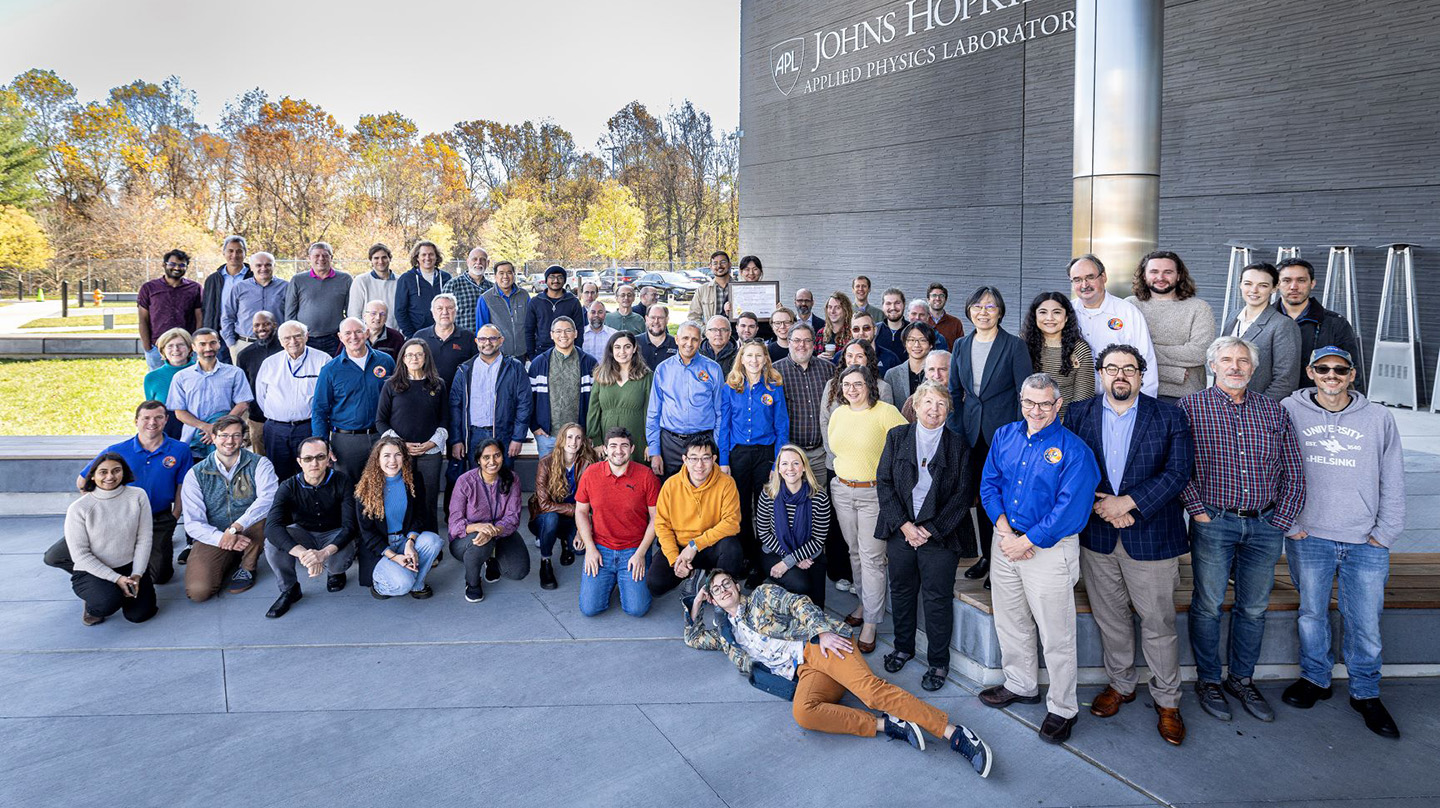News
Parker Solar Probe Team Garners NASA Honors
NASA’s Parker Solar Probe team has earned agency honors for its novel efforts to guide a spacecraft toward record-setting close distances from the Sun — and revealing more about our star than mission planners and scientists ever expected.
NASA presented its Group Achievement Award to the Parker team during a mission Science Working Group meeting on Nov. 6 at the Johns Hopkins Applied Physics Laboratory (APL) in Laurel, Maryland. APL designed, built and operates Parker Solar Probe and manages the mission for NASA’s Science Mission Directorate.
“Since launch five years ago, the Parker Solar Probe mission has made numerous, substantial contributions to our knowledge of the Sun and the near-Sun environment,” said Peg Luce, acting director of NASA’s Heliophysics Division. “There have been discoveries, and the team deserves significant credit for finding ways to enhance the spacecraft beyond the spectacular capabilities it already has.”
NASA specifically lauded the team’s novel engineering that has enabled the spacecraft to collect nearly three times as much data as required — leading to discoveries the Parker team didn’t anticipate. Considering power conservation and safety margins for operating in an unexplored environment, the team devised a prelaunch plan that called for Parker’s four science instrument suites to operate primarily when the spacecraft was closest to the Sun, about 11 days per each (approximately) 90 days it took to loop around the inner solar system. It was also going to transmit about 85 gigabits of the science data it collected during each orbit.
Not long after launch in August 2018, as the team began operating its spacecraft, they demonstrated the ability to push those limits and operate Parker’s instruments through most of each orbit — including during the flybys of Venus it uses to shape its trajectory. By extending the full capabilities of the spacecraft’s guidance and control system, the team not only increased the amount of space the instruments can explore but also boosted the amount of data being sent back — more than 275 gigabits beamed home during Parker’s 16th orbit this past spring.
“This award is such a tremendous accomplishment for the whole Parker team,” said Helene Winters, Parker Solar Probe project manager at APL. “Parker Solar Probe is changing the field of heliophysics. After five years of braving the heat and dust of the inner solar system, taking blasts of solar energy and radiation that no spacecraft has ever seen, Parker Solar Probe continues to thrive.”
In early 2021, Parker Solar Probe achieved a cornerstone objective, making the first measurements from within the atmosphere — or corona — of the Sun. This allowed mission scientists to add to their list of major discoveries, which includes:
- Evidence that small-scale jetting in the Sun’s corona, driven by a process called magnetic reconnection, is responsible for the heating and acceleration of the solar wind
- Observations that dust — scattered throughout our solar system — begins to thin out close to the Sun, evidence of a long-theorized dust-free zone near our star
- Insights into the structure of the solar wind, tracing the origin of switchbacks — magnetic zig-zag structures in the solar wind — back to the solar surface
- Detections of radio emissions from Venus’ ionosphere, and the first-ever images of Venus’ surface in visible wavelengths
“One fascinating aspect of Parker Solar Probe is the mission’s continual evolution,” said Nour Raouafi, Parker Solar Probe project scientist at APL. “In the first two years following the 2018 launch, the Sun remained notably quiet, as it was near ‘solar minimum’ in its 11-year solar cycle. However, as the spacecraft gradually approached the Sun, solar activity intensified due to the fact that the Sun is approaching ‘solar maximum.’ This evolution in time and space enabled the sampling of the space closer to the Sun, and a solar atmosphere reshaped by the magnetic activity.”
All told, the mission team has published nearly 900 peer-reviewed papers on its discoveries with more than 15,000 citations — and there’s more to come. Parker makes the 18th of 24 planned close approaches to the Sun on Dec. 29, with the first of the three closest passes — which will bring it inside 3.9 million miles (6.3 million kilometers) of the Sun’s surface, while moving faster than 430,000 miles per hour (692,000 kilometers per hour) — coming on Dec. 24, 2024.
“For designing, building and operating this revolutionary spacecraft on time and on cost, to delivering incredible science results that are rewriting the textbooks, the Parker Solar Probe team has set an incredibly high bar,” said Andy Driesman, mission area executive for Civil Space Flight at APL. “This team has earned this recognition. We are looking forward to humanity’s closest approach to the Sun on Christmas Eve 2024.”
Parker Solar Probe was developed as part of NASA’s Living With a Star program to explore aspects of the Sun-Earth system that directly affect life and society. The Living With a Star program is managed by the agency’s Goddard Space Flight Center in Greenbelt, Maryland, for NASA’s Science Mission Directorate in Washington. APL designed, built and operates the spacecraft and manages the mission for NASA. Learn more at https://nasa.gov/parkersolarprobe and https://parkersolarprobe.jhuapl.edu.

